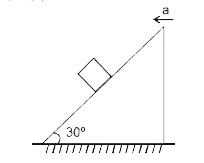A block of mass 5 kg is kept against an accelerating wedge with a wedge angle of 45∘ to the horizontal. The coefficient of friction between the block and the wedge is μ=0.4. What is the minimum absolute value of the acceleration of the wedge to keep the block steady? [Assume, g=10ms2]
![A block of mass 5 kg is kept against an accelerating wedge with a wedge angle of 45^(@) to the horizontal. The coefficient of friction between the block and the wedge is mu = 0.4. What is the minimum absolute value of the acceleration of the wedge to keep the block steady? [Assume, g = 10 m/s^(2)]](https://d10lpgp6xz60nq.cloudfront.net/physics_images/ARH_5Y_SP_04_05_18_01_E02_008_Q01.png) Solution in Telugu
Solution in Telugu
607m/s2
307m/s2
30√7m/s2
60√7m/s2
The correct Answer is:B
Let a = acceleration of wedge, then force on block due to acceleration of wedge = ma.

Then, from FBD we have,
For equilibrium of block,

mg sina=ma cosα+μ(ma cosα+ma sinα)
⇒g=a+μ(g+a)⇒0.61.4g=9
⇒ a=307ms−2
Topper's Solved these Questions
Similar Questions
A force F is applied in a square plate of length L . If the percentage error in the determination of L is 3% and in F in 4% then permissible error in the calculation of pressure is
View SolutionA tokamak fusion test reactor works on
View SolutionIn the adjoining figure, the coefficient of friction between wedge (of mass M) and block (of mass m) is μ.
Find the minimum horizontal force F required to keep the block stationary with respect to wedge.

View SolutionA block of mass m is at rest relative to the stationary wedge of mass M. The coefficient of friction between block and wedge is mu . The wedge is now pulled horizontally with acceleration a as shown in figure. Then the minimum magnitude of a for the friction between block and wedge to be zero is:
View SolutionA block of mass m is placed on a smooth wedge of inclination. The whole system is accelerated horizontally so that block does not slip on the wedge Find the i) Acceleration of the wedge Force to be applied on the wedge Force exerted by the wedge on the block .
View SolutionCalculate angle of friction between wedge and block system is at rest M coefficient of friction between wedge and block.
View SolutionTwo small blcok m=2kg each kept on wedge of mass 12 kg . There is no friction between blocks and wedge coefficient of friction between wedge and ground in mu=0.3 . Calculate frictional force by ground on wedge.
View SolutionA block of mass m is placed on the rough incline of a wedge of mass M and inclination α to the horizontal. Calculate the maximum and minimum acceleration that can be imparted to the wedge so that the block may remain stationary relative to the wedge. The coefficient iof friction between the block and the wedge is μ.
View SolutionA block of mass 2 kg is kept on a smooth wedge of mass 3 kg and wedge is kept on a rough horizontal surface. A vertical force of 60 N is applied on the minimum coefficient of friction between the wedge and horizontal surface, so that wedge remains at rest during the motion of block on the wedge ?
View SolutionIn the arrangement shown in the fig. the block of mass m lies on the wedge. Wedge is moving with acceleration a = 5 m/sec Find the wedge acceleration of the block with respect to wedge.
View SolutionIn the arrangement shown in the fig. the block of mass m lies on the wedge. Wedge is moving with acceleration a = 5 m/sec . Find the wedge acceleration of the block with respect to wedge.
View SolutionA block of mass m is placed on a wedge of mass M. Coefficient between then is μ<cotθ. The wedge is given an acceleration to its left. Find the maximum acceleration at which block apears stationary relative to wedge.

View SolutionA block of mass m is placed on a wedge of mass M. Coefficient of friction between them is mu gt cot theta. The minimum acceleration of the wedge at which block appears stationary relative to wedge is
View Solutionचित्र में गुटके व वेज के मध्य कोई घर्षण नहीं है। गुटके को वेज पर स्थित रहने एक लिए वेज का त्वरण a होना चाहिए।

View SolutionIn the adjoining figure, the coefficient of friction between wedge (of mass M) and block (of mass m) is μ.
Find the minimum horizontal force F required to keep the block stationary with respect to wedge.

View Solution
